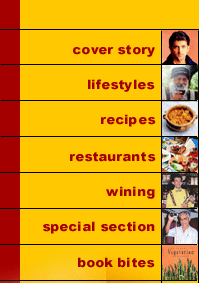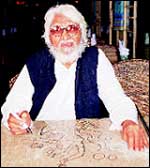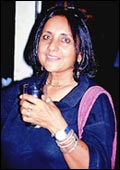


 BUSYBEE makes a nostalgic round of USHA KHANNA�S Samovar, the boutique restaurant that feeds artists, writers, musicians, newspaper and advertising people, tourists and students. |
|
Samovar The Art Cafe
I have often wondered whether the Samovar is attached to Bombay�s Jehangir Art Gallery or the Jehangir Art Gallery is attached to the Samovar. Probably, the latter. People come to the Samovar to eat muli-alu parathas dipped in creamy cucumber raitas, and later, on their way home, take a look at the paintings in the gallery.
The Samovar is Mrs. Usha Khanna�s art boutique cafe. It feeds artists, hungry and successful, writers, musicians, people of the nether world, also newspaper men, advertising executives, students, and occasionally a tourist who wanders into the gallery and finds himself in the restaurant. The clientele is eclectic, Mrs. Khanna maintains a scrapbook and it is filled with comments and sketches from talents as varied as V. S. Naipaul and M. F. Husain. I am a regular there, partly because of the food, partly the company, and mainly the ambience.
It is not arty, the ambience, I mean, even when the very proper Jehangir Sabavala delicately cuts the wedges off his chutney sandwiches. Nor is it rambunctious, not even when the Bohemian Francis Newton Souza lines up the beer bottles. There is much camaraderie between B. Prabha and Imtiaz Dharker, and occasionally R. K. Laxman suspiciously inspecting his food.
Not that there is anything to be suspicious about the food - that is Mrs. Khanna�s forte. Her rotis are whole wheat, no short-cuts with maida, her butter Amul, her cooking medium Postman, and her cooks have been with Samovar for 30 years and more. The ingredients are selected as by a housewife for her own kitchen. The masalas are ground and the chutneys made daily, and since the menu changes every day, no food is placed in cold storage for tomorrow. Lunch normally gets exhausted by 2.30, go early.
I normally skip the lunch hour, go in the late afternoon, when Keikoo Gandhi comes down from his gallery upstairs, Husain wanders in barefoot, lawyers come from the high-court for their afternoon tea, or a tall glass of water-melon with a peel of lemon in it reported to be the coolest drink in the world. It is a long, narrow restaurant, a straight corridor with tables for four on both sides.
You wedge your way in between the tables, careful not to knock down a plate of chicken biryani or a glass of sweet lassi. One side of the restaurant is open to the gardens of the Prince Of Wales Museum, arguably the best tended garden in town. Khushwant Singh, who was a regular during his days in Bombay, sitting in the restaurant and looking out at the garden could name every tree around. And, in the early evening, when the birds returned to their trees, name them.
The museum garden is probably the best thing about the place, it gives the place an open air feeling. But there is a roof over the diners� heads and there is no possibility of getting wet. I sit there and watch the rain fall among the trees and flowers, and change my order from the usual chilled beer to hot coffee. That�s when Mrs. Khanna comes over and says: �Good boy.� She has maternal feelings about most of her customers. She is a very maternal lady, protective and caring.
Through her Samovar she has brought up three children, educated them and got them married. Husband Rajbans Khanna was an idealist and a dreamer, he made movies - leftist, intellectual. In his later years, he would sit in Samovar and write scripts. I would sit with him and talk. He is dead now, a lot of people I used to share tables with at Samovar are gone. K. H. Ara, my friend, he once took me to his studio and told me: �Take anything you want.
I took one large fat lady, without clothes. And Kali Pundole, art impresario, he is dead. And Pearl Padamsee died recently. And poor Nissim Ezekiel, the finest art critic that Bombay has ever had, he is no more in touch with this world.
Samovar brought them all together, and Mrs. Khanna. It was when the Jehangir Art Gallery opened, thanks to the munificent contribution of Sir Cowasji Jehangir. Mrs. Khanna had gone there to see some paintings, and she was talking to Soli Batliwalla, the curator. It was an excellent facility, but some small place was required for artists and their admirers to sit and talk and have a cup of tea.
You supply the tea, I will provide the chairs, Mr. Batliwalla told her, giving her four chairs to place in the corridor. The next day she arrived at the gallery with a stove and a bucket, and Samovar began. It is more than a quarter century now, nearer 30 years, there is a range of food available at affordable prices, and the purpose has not been forgotten, a place for artists and their friends to meet.
Some of the food, presently served, was invented by Samovar. For instance, the roti rolls, the Indian hamburgers. The first two rolls were the kheema and kebab rolls. The kebab was minced meat, with the fat removed. Seasoned with cinnamon, coriander, green chillis, fresh ginger and a few mint leaves.
The kebabs rolled in green chutney, with lettuce and onions in two chapattis, served with fresh salad. Later, the boti roll was evolved, succulent pieces of meat, and recently they have introduced chicken vindaloo in a roti roll. The other first at the place are the stuffed parathas. Ten different stuffings, muli, gobi, palak, paneer, corn, sprouted mung, egg (an egg burji is made and stuffed in the paratha), and a pizza paratha.
The base of the pizza is stuffed in the paratha, along with the pizza paste of tomato, onion, garlic, cooked and made into a thick sauce. The cheese is placed on the top of the paratha. My favourite is the methi-alu paratha with the tamarind chutney, and make sure to ask for the tamarind chutney. It is made with tamarind pulp, ginger, green chillis, onions, coriander leaves. roasted jeera and a touch of sugar.
With the parathas, I would suggest a raita. There is a whole range, cucumber, tomato-phudina, brinjal (fried), beetroot (half cooked). Ask for the palak raita, done in Sindhi style. The palak is finely chopped and boiled, and put in a tadka of rye, curry patta and hing, then dahi is added to it.
But the Samovar�s original favourite and one that has lasted out the test of time, is the dahi wada. The wadas are made from udad dal, soft and they become softer after being dumped in the dahi. The dahi is made from two litres of milk, set overnight. Not too firm and its texture is velvety. The important element is the red chutney that is placed on the top of the dahi wada.
The recipe for the red chutney is Mrs. Khanna�s and it is a secret between her and her main chef. It is made from dates, tamarind, chopped ginger and onions, green chillis, dhania, mint, sugar, salt, red chilli powder, and one secret ingredient. Together they make an attractive combination, the wadas wrapped in the dahi cool and sweet, the chutney hot and a little sharp.
There is a lot of regular food also. Daily three curries, mutton, chicken and prawn, the prawn curry is Goa style, small prawns, coconut, Kashmiri chillis. Plus, daily one dal, mutton biryani, prawn and vegetable pulaos. And, in the evening, with tea, there are large Punjabi samoosas, only these samoosas are stuffed with kheema.
I shall end the piece with a quote from Usha Khanna�s scrapbook. It�s a little poem, scribbled by a German budget tourist, who wandered into Samovar one afternoon and wandered out.
He writes:A Russian Samovar,
|

Home Page
About the mag
Subscribe
Advertise
Contact Us

